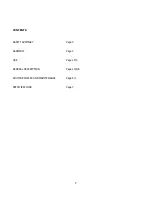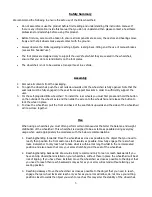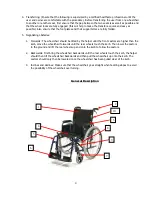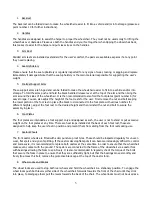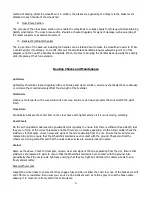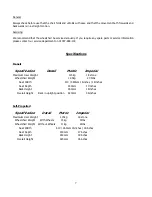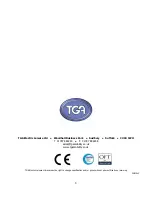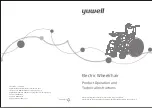
5
1.
Backrest
The backrest can be folded down to make the wheelchair easier to fit into a vehicle and/or into storage (please see
point number 10 for further instructions).
2.
Handles
The handles are designed to assist the helper to propel the wheelchair. They must not be used solely for lifting the
wheelchair over obstacles. Please use both the handles and your feet together when tipping the wheelchair back,
this makes it easier for the helper and puts less stress on the handles.
3.
Arm Rest
Padded arm rests are installed as standard for the user’s comfort, the pads are available as spares if at any point
they need replacing.
4.
Seat Upholstery
Please ensure that the seat upholstery is regularly inspected for any signs of wear, tearing or sagging and replace
immediately if damaged. Note that the seat upholstery is the main material responsible for supporting the user’s
weight.
5.
Footrest Support Arms
These support arms are hinged and can be folded to make the wheelchair easier to fit into a vehicle and/or into
storage. To fold the arms push and hold the black-handled release lever at the top of the arm and then bring the
arm around the sides of the wheelchair. It is then recommended to also fold the foot plates (point number 6) for
easy storage. You can also adjust the height of the foot rests for the user: First remove the nut and bolt keeping
the lower portion of the foot rest in place (the black rod connected to the foot plate with various notches for
different heights), adjust the foot rest to the desired height and then reinstall the nut and bolt to secure the
assembly in place.
6.
Foot Plates
The foot plates are intended as a foot support only and designed as such, the user is not to stand or put excessive
weight on the foot plates at any time. There are heel loops installed at the back of each foot rest, these are
designed to help keep the users feet in position and prevent them from sliding from the foot rests during use.
7.
Castor Wheels
The front castor wheels are fitted with solid, puncture proof tyres. These should be inspected regularly for uneven
wear, flat spots and signs of splitting. If the castors develop flat spots it can become increasingly difficult to control
and manoeuvre, it is recommended to replace both castors at the same time in order to ensure that the wheelchair
makes even contact with the ground. The castors are connected to the frame of the wheelchair via a castor fork
with bearings allowing the forks to spin freely. It is also recommended to regularly check the torque of the bolts
that secure the forks in place to ensure that they are sufficiently tight, but that the bearings move smoothly and
freely (to access this bolt, remove the protective black cap at the top of the castor fork).
8.
Wheel Locks and Brakes
The wheel locks are used to stop both rear wheels and hold the wheelchair in a stationary position. To engage the
wheel locks push both levers either side of the wheelchair forwards towards the front of the chair until they click
into place, to disengage them pull the levers towards the back of the chair. The wheel locks must not be used as a


